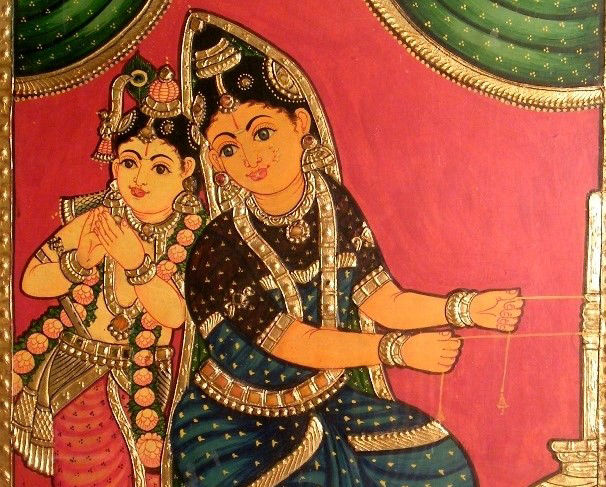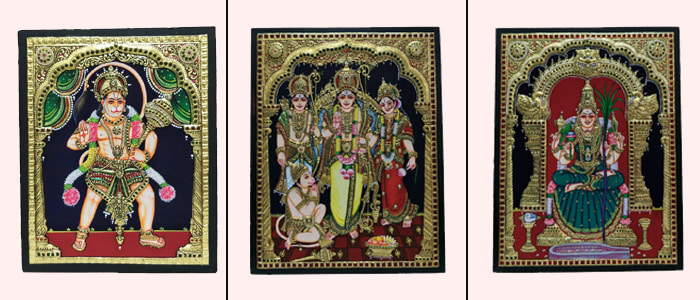Thanjavur has a unique place in the history of Indian painting. The dense composition, surface richness, and vibrant colors of Indian Thanjavur Paintings distinguish them from the other types of paintings. These paintings are very ancient and miniature types of paintings. Paintings mainly consist of the main figure usually a deity, the figure appears prominent in paintings with a well-rounded body and cherubic face. The main figure is enclosed in a meticulously crafted enclosure in form of arch or curtain. The paintings are bright and vibrant.
The inspiration for Tanjore paintings was derived from various art forms such as classical dance, music, and literature. Most of these paintings are based on themes of Hindu Gods and Goddesses and scenes from Hindu mythology. The most popular subjects include Krishna on a swing with a buttered bowl, Lord Ganesha, baby Ganesha hugging a Shiva Linga, Pendant Krishna, Yashoda and Krishna, and Krishna with his consorts. In the later years, the paintings also included some depictions of Jain, Muslim, Sikh as well as secular subjects like fairs and festivals along with flora and fauna.

Making of Tanjore Painting
Of the numerous steps involved in the making of a Tanjore Painting, the first involves drawing of the preliminary sketch of the image on the base. The base is made up of a cloth, which is pasted over a wooden base. The second step consists of mixing chalk powder or zinc oxide with water-soluble adhesive and applying it on the base. Thereafter, the drawing is made and ornamented with cut glass, pearls, and even semi-precious stones. Laces or threads may also be used to decorate the painting. To further augment the effect, wafer-thin sheets of gold are pasted in relief on some parts of the painting, while the other parts are painted in bright colors.

The subjects of Tanjore paintings are portrayed with cherubic faces and almond-shaped eyes. The main characteristics of these paintings are their brilliant color schemes, decorative jewelry with stones cut glasses, and gold leaf work. The liberal use of gold leaf precious and semi-precious stones presents a splendid visual treat. Adorned with rubies, diamonds, and other precious gemstones, and trimmed with gold foil, the old Tanjore paintings were the true treasures. The original Tanjore paintings were made using lime and tamarind seed powder on cloth stretched over a wooden canvas. Earlier. the artists used natural colors, vegetable dyes, and mineral dyes. Presently the artists use chemical paints.
Mysore Paintings and Tanjore Paintings both share many characteristics in similar that leads to confusion between the two. Though the styles are similar, they differ in a few areas. Mysore Paintings use paper for the base and limited gold foil and precious stones.
Explore more from our collection of Paintings that never fails to add charm and beauty to your Home Decor.









































